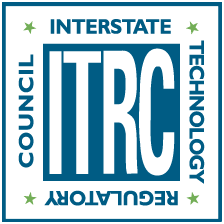Introduction
Evaluating the remedy and key decision points during implementation of an IDSS involves answering rather simple questions:
- Are the functional objectives being met?
- Is progress toward the functional objectives acceptable?
- Can objectives be achieved with greater efficiency?
- How do you troubleshoot the remedy if objectives are not being achieved?
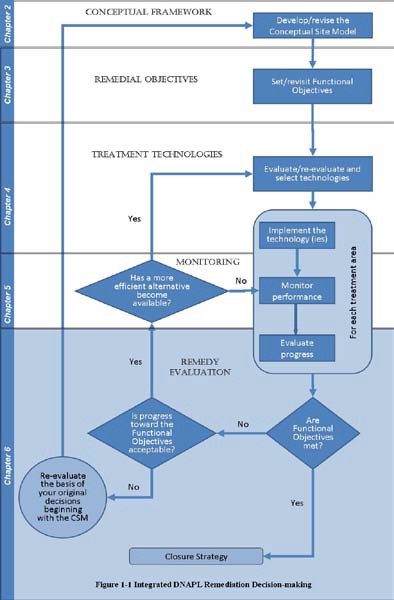
This chapter describes the reevaluation of a remedy when progress toward functional objectives is not acceptable. Practically, most sites at which an IDSS is under consideration are at a point where the remedy is not making acceptable progress towards achieving the functional objectives (Section 6.1). Currently, reevaluation of these sites often focuses on technology application without also reevaluating whether the CSM or the absolute and functional objectives are impeding measureable progress. The process model provided in
this chapter includes consideration whether, even if progress is being made toward achieving functional objectives, optimization of the strategy is warranted to achieve success most effectively (Section 6.2). The process model also outlines steps for reevaluating a site, including addressing inadequate CSMs (Section 6.3.1), functional objectives (Section 6.3.2), or the remedial technologies (Section 6.3.3).
6.1 Evaluate Whether Objectives Are Being Met
Periodic reviews of the data and the overall strategy are generally required (e.g., 5-year reviews under the CERCLA process) and should be conducted with any long-term remedy. A variety of tools and methods can effectively synthesize data to establish whether progress towards objectives is being made, as discussed in Chapter 5. The timing of a remedy review varies depending on the expected objectives and anticipated remedial rates and outcomes. For instance, if a remedy is intended to last 20 years, 5-year reviews may be sufficiently frequent for evaluation, optimization, and troubleshooting. However, the timing of reviews must be sufficiently frequent to allow for the contingency to alter the plans or remedy if not performing as expected. For instance, if the remedy includes source treatment to reduce contaminant mass discharge within 5 years, a 5-year review does not provide sufficient time to troubleshoot the source treatment. The review may be comprehensive (e.g., CERCLA 5-year review) or may evaluate only one functional objective (e.g., whether source treatment reduced contaminant mass discharge within the first 5 years). Therefore, review periods must be consistent with the time frames of the functional objectives. Guidance that is helpful during these reviews includes AFCEE 2006, USACE 1999b, and ITRC 2004a.
Generally, performance evaluation of the remedy should identify changes that have occurred, remaining potential risks, and opportunities for improvement (i.e., optimization). It is important that the functional objectives are SMART, that sufficient and appropriate data are collected that directly support decision making regarding a specific functional objective (e.g., USEPA 2006 and 2005b outline procedures for aligning data collection strategies to objectives), and that the desired outcome is clearly understood and accepted. Table 6-1 describes examples of objectives described in Table 5-5 and provides examples of how those objectives might be evaluated, including time frames for performance review.
6.2 Remedy Optimization—Can Objectives be Met with Greater Efficiency?
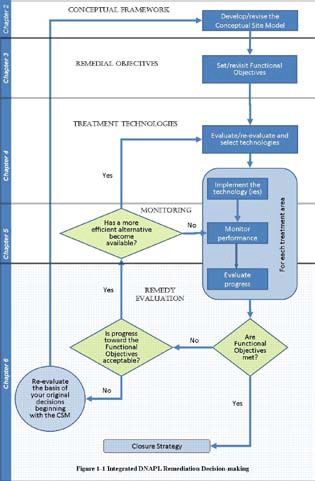
An important component of a remedy reevaluation is investigating whether best practices have been implemented and whether the current practices are consistent with any new findings to ensure that the functional objectives are being pursued as efficiently as possible. There are often significant changes in site management over the course of a long-term environmental restoration process due to the dynamic nature of environmental law, ever-improving remedial technologies, and improved understanding of impacts of remedial actions (including green and sustainable practices). A decision to optimize the original strategy is typically based on a variety of site-specific factors:
- cost reduction, whether monetary, temporal, or sustainability-based
- changes in resource use (e.g., property transfer)
- potential incorporation of new technologies
- enhanced operation of an existing technology or system state-of-the-art practices
| Technology optimization focuses on refining technology process operational parameters and controlling site conditions (e.g., injection or feed rate, soil or groundwater pH or Eh, etc.) to more closely match the requirements of the treatment and achieve functional objectives more cost-effectively (see Text Boxes 6-1 and 6-2). |
Text Box 6-1. Caldwell Trucking, Optimizing In Situ Treatment (see Appendix A)
A full-scale field test using enhanced biological treatment from January 2001 to July 2002 was designed to determine whether enhanced bioremediation was viable to treat residual DNAPL in the basalt bedrock. The test goals were to accelerate the dissolution and treatment of source material and reduce the overall lifetime and impact of the source, rather than to achieve specific concentration reductions (NRC 2005).
Text box 6-2. Test Area North, Optimizing In Situ Treatment (see Appendix A)
The results of abiotic column studies confirmed that the dissolution of TCE DNAPL was enhanced during amendment with high concentrations of some electron donors. Of these, a whey powder solution enhanced TCE DNAPL dissolution by a factor of 6 while sodium lactate had a much smaller impact (Macbeth et al. 2006).
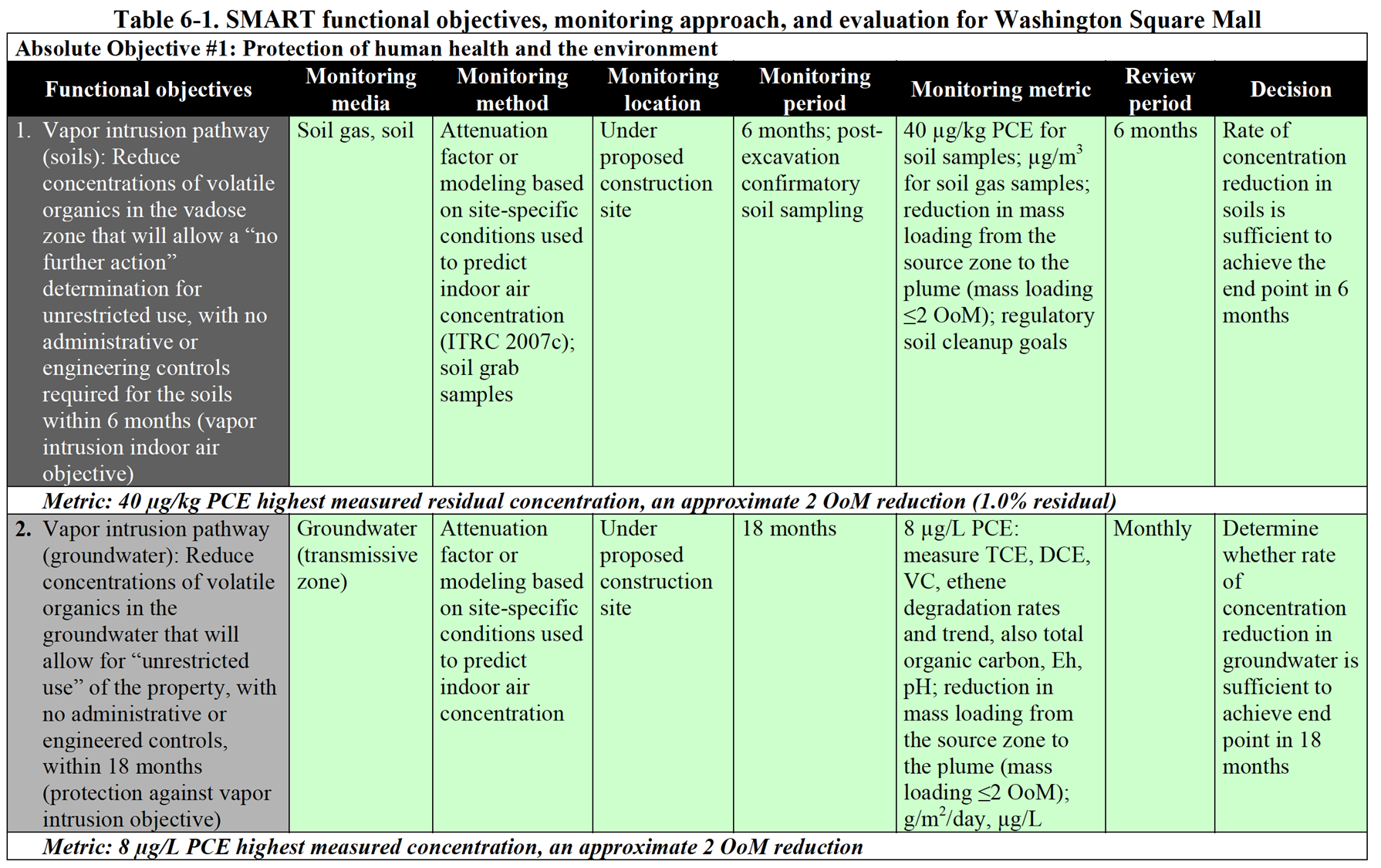
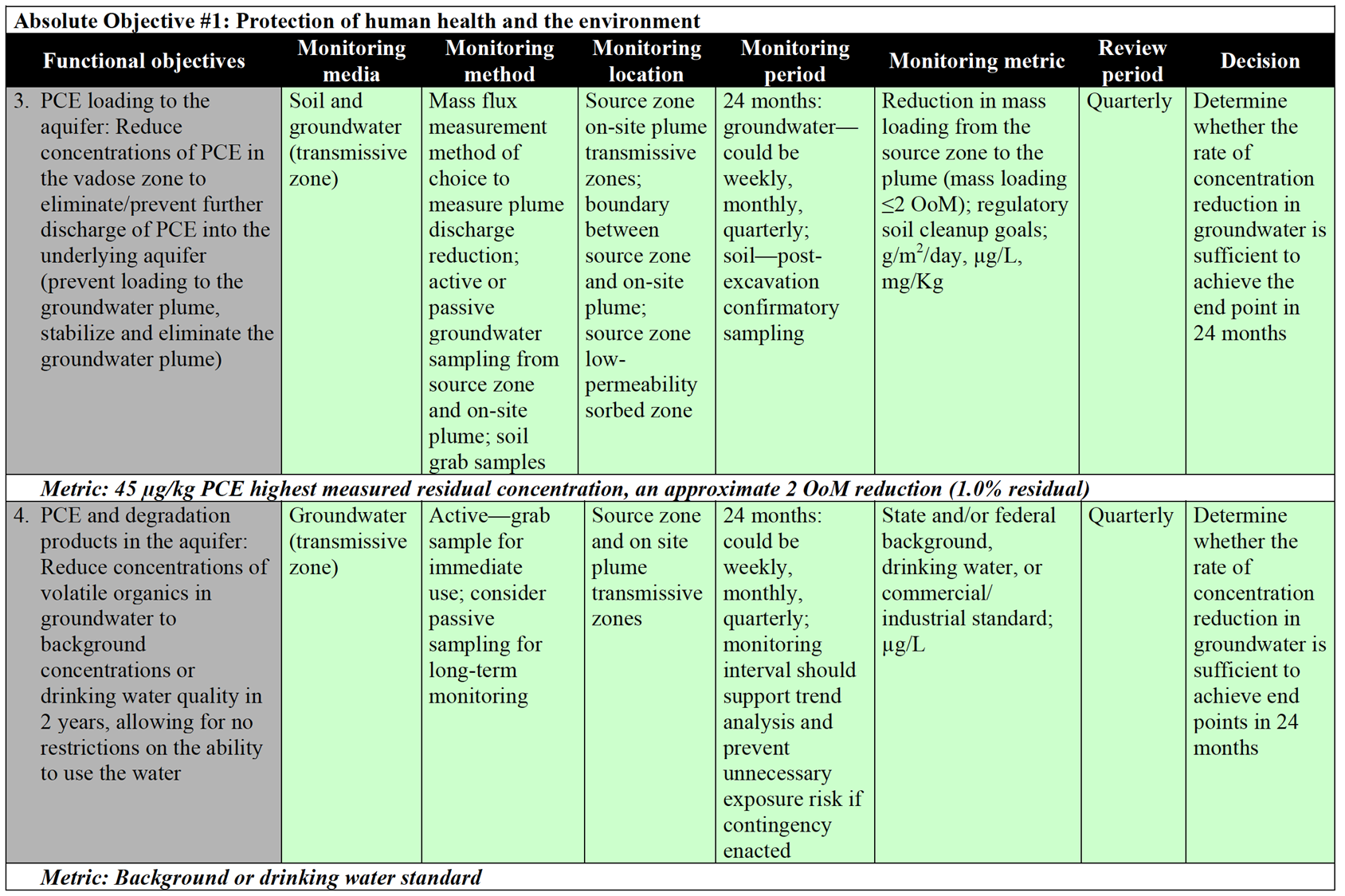
Each stage (e.g., screening, evaluation, design, and implementation) of a response action can be optimized. Table 6-2 summarizes four optimization reviews. ITRC (2004a) published specifics on remedial process optimization, and a series of five brief ITRC guidance documents (ITRC 2006a–e) detail the key aspects of remedial process optimization.

Each stage (e.g., screening, evaluation, design, and implementation) of a response action can be optimized. Table 6-2 summarizes four optimization reviews. ITRC (2004a) published specifics on remedial process optimization, and a series of five brief ITRC guidance documents (ITRC 2006a–e) detail the key aspects of remedial process optimization.
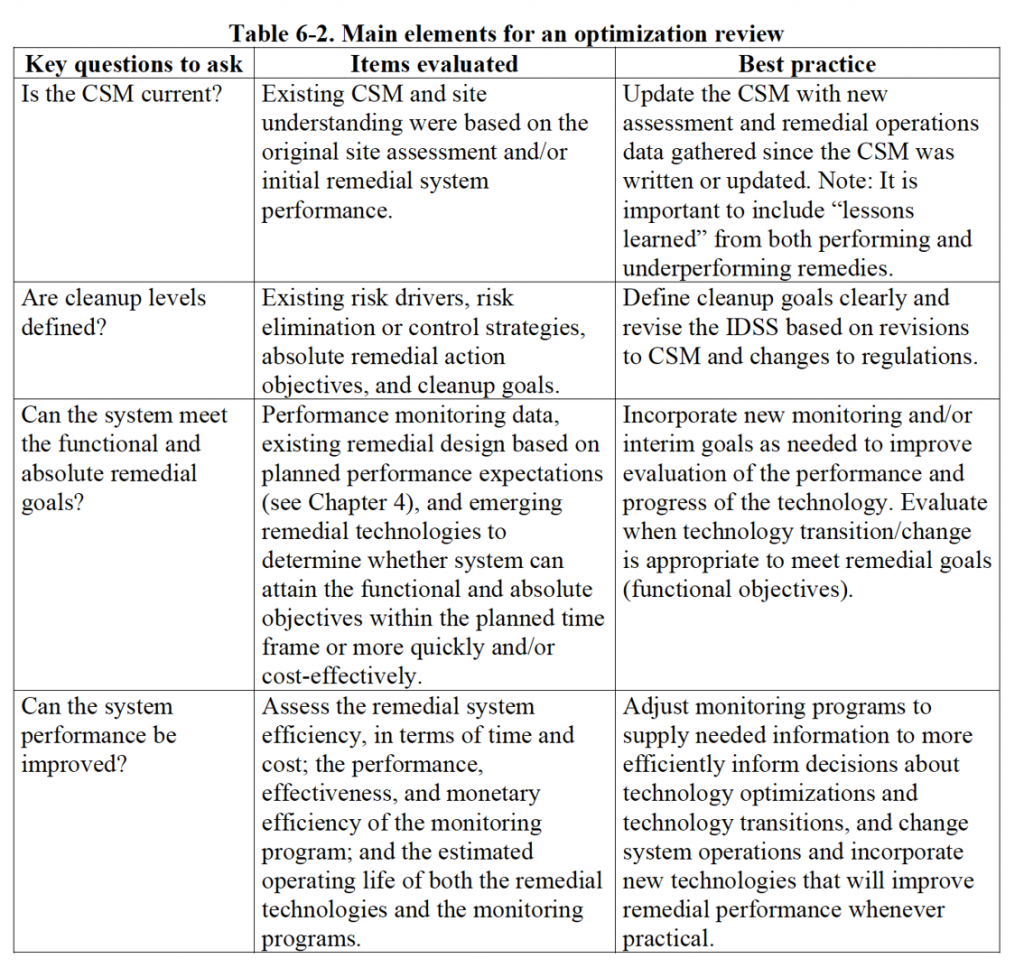
6.3 Remedy Evaluation
If project objectives are not being achieved at an acceptable rate or cost, the IDSS should be evaluated to determine whether one or more components of the strategy (i.e., CSM, functional objectives, or technology selection) should be revised. The three elements of the IDSS reevaluation process model are discussed below.
6.3.1 CSM Evaluation
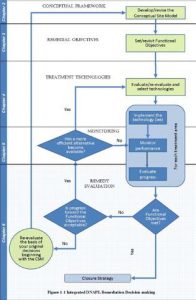
The CSM (Chapter 2) incorporates all available assessment and remedial operations data into a single document. Given the comprehensive nature of a CSM, it usually takes more than one format to organize and display all the site information. CSM representations may include a text description supported by appropriate figures (e.g., site maps, cross sections, block diagrams, etc.), a release-transport-exposure depiction, and an exposure pathway analysis used to support the risk assessment (NAVFAC 2010b). Computer model simulations or exposure scenario models may be a component of the CSM but are not the entire CSM. Appendix C includes a CSM checklist that can be used to identify important elements of a CSM and determine whether elements are missing. CSMs are often used to do the following:
- organize project information
- obtain consensus about sources of uncertainty
- identify uncertainty that hampers decision making
- identify additional data collection needed either to reduce CSM uncertainties or to test CSM assumptions
- establish a single basis for all site decisions about risk, remediation, and reuse
- establish a basis for decisions regarding remedial cost-effectiveness and efficiency
- establish a basis for identifying decision units (i.e., area, volume, or a set of objects that is treated as a single unit for decision making)
Design and anticipated operations of the initial remedial system at any site are based on the original, primarily assessment-based CSM. The CSM can and should be revised throughout the different stages of a remedy, including remedial design and implementation, to improve the quality of the CSM and to ensure that essential information is included. Evaluating uncertainty in the CSM is critical and can help identify data gaps and actions that should be taken to reduce uncertainty in the CSM, thereby also reducing uncertainty in the project decision making. The CSM is a living document continually updated with additional investigation and lessons learned during remediation or on an expanding body of data gathered throughout the remediation (USEPA in press). Thus, the CSM “matures” throughout the project implementation, and as the quality of the CSM improves, so do decisions based on the accuracy of the CSM.
The CSM assembled from the findings of a remedial investigation (RI) often does not adequately portray the site conditions over time due to faulty or incomplete information, changing conditions since the RI (e.g., remedial actions), or the lack of essential information that is specific to a given remedial technology. An inaccurate or incomplete CSM can result in poor decision making, severely impacting both the duration and the cost of a remediation project. Deciding whether the CSM should be revised is aided by using the CSM checklist to decide whether essential elements are missing or inadequate (see Appendix C) and available tools, including hydrogeologic models, contaminant fate and transport models, and three-dimensional visualization software that quantify the uncertainty in the site conditions. Table 6-3 summarizes these tools and whether they specifically include uncertainty analysis.
Table 6-3. Summary of models used within the environmental industry to develop CSMs and evaluate uncertainty
| Model | Solution method | Intended application | Capabilities and access | Uncertainty |
| BioBalance Tool Kit | Mass balance approach | Source and/ or A-D fate and transport | Evaluate natural attenuation capacity at site. Includes four modules (source, competition, electron donor, and plume) and combines the modules for the final mass balance. www.gsi-net.com | |
| BIOCHLOR | Analytical solution | Source and/ or A-D fate and transport | Fate and transport of chlorinated solvents (first- order decay). https://www.epa.gov/water-research/biochlor-natural-attenuation-decision-support-system | |
| NAS | Combination of analytical and numerical solutions | Source and/ or A-D fate and transport | Includes three main interactive modules to provide estimates for distance of stabilization, time of stabilization, and time of remediation. www.cee.vt.edu/NAS | Yes |
| REMChlor | Analytical solution | Source and/ or A-D fate and transport | Fate and transport of chlorinated solvents (first- order decay). Allows user to remediate source and/or plume at different times and different locations. https://www.epa.gov/water-research/biochlor-natural-attenuation-decision-support-system | Yes |
| BIOPLUME | Numerical solution (up to two dimensional) | Primarily A-D fate and transport | Fate and transport via inputting site-specific hydraulic and attenuation parameters. https://www.epa.gov/water-research/biochlor-natural-attenuation-decision-support-system | |
| MT3D | Numerical solution (up to three dimensional) | Primarily A-D fate and transport | Fate and transport via inputting site-specific hydraulic and attenuation parameters. www.scisoft- gms.com (typically used in commercial software package) | |
| RT3D | Numerical solution (three dimensional) | Primarily A-D fate and transport | Fate and transport via inputting site-specific hydraulic and attenuation parameters. www.scisoft- gms.com (typically used in commercial software package) | |
| SEAM3D | Numerical solution (three dimensional) | Primarily A-D fate and transport | Fate and transport via inputting site-specific hydraulic and attenuation parameters. | |
| SourceDK | Analytical solution | Primarily source | Remedial time-frame decision-support tool that can evaluate data using three tiers. Tier 1 relies on empirical data, Tier 2 uses a box model, and Tier 3 uses a process model. www.gsi-net.com | |
| Mass Flux Toolkit | Analytical solutions | Estimates mass flux and discharge | Estimates mass flux and discharge based on date collected across a transect of a contaminant plume. | Yes |
| Environmental Visualization | Numerical solutions (three dimensional) | Three dimensional visualizations | Three-dimensional visualization software with geostatistics to integrate site geologic, hydrogeologic, and contaminant data to provide quantitative assessment of the quality of a site investigation (min-max plume technology, confidence, and uncertainty) and identification of data gaps. | Yes |
If the CSM does need to be revisited, then it is necessary to identify specific data gaps and formulate activities to fill those data gaps. If not, then one should proceed to revisiting the functional objectives.
6.3.2 Common CSM inaccuracies
Chlorinated-solvent site CSMs are complex. Minor inaccuracies in one or more elements that affect the same subsurface element can interact multiplicatively, increasing departures from true subsurface conditions. Such inaccuracies occur most often in structure of the source area and plume and in geochemistry.
Text box 6-3. Test Area North, Reevaluation of the CSM (see Appendix A)
The Test Area North CSM was developed through an iterative process of identifying data gaps, conducting activities to fill those data gaps, reporting on the results of those activities, and identifying new data gaps. This process resulted in a series of four reports. Following are examples of characterization activities that have been conducted in the source area since the sludge removal activity was completed and before the ISB field test was implemented:
· Several wells have been installed within or adjacent to the source area.
· Pumping tests, slug tests, and tracer tests have been conducted to determine aquifer properties, from which residual source distribution has been inferred.
· Standard geophysical, gamma spectroscopy and acoustic televiewer logging were performed in several source area wells.
· Cross-well seismic tomography was conducted.
· Extensive groundwater sampling has been conducted throughout the source area, both in support (see Section 2.3) and prior to initiation of ISB operations.
· Furthermore, results of abiotic column studies confirmed that the dissolution of TCE DNAPL was enhanced during amendment with high concentrations of some electron donors. Of these, a whey powder solution enhanced TCE DNAPL dissolution by a factor of 6 while sodium lactate had a much smaller impact (Macbeth et al. 2006). ISB remedy was initially implemented using sodium lactate injections and then optimized with whey injections.
These activities greatly improved the understanding of aquifer hydraulic conductivity, porosity, and preferential flow paths; dissolved contaminant composition and distribution; and residual contaminant source distribution.
Structure of the source area and the plume requires a full understanding of all compartments where contamination exists to design an effective remedy. The distribution is dictated by the factors discussed in Chapter 2. Where the contamination resides changes over time. The elements controlling subsurface transport and contaminant reactions (Section 2.2) within the source area and plume need to be evaluated periodically to assess whether adjustments to the remedy can improve the remedy effectiveness (See Text Box 6-3). Typical components of the CSM related to source and plume structure that can cause inaccuracies include the following:
- Three-dimensional delineation— The depth, width, and length of the source and plume and the distribution of contaminants within the source area and plume are often incomplete. Three- dimensional investigations are often accomplished using vertical profiling with sensors on direct- push probes (e.g., membrane interface probes) or with nested wells that collect continuous data or are screened and sampled over narrow intervals. These methods are particularly helpful when multiple water-bearing zones are impacted.
- Boundary conditions—Hydrogeologic features that influence groundwater flow can include surface water, regional pumping wells, etc., all of which can change. For example, a pumping well may influence the direction and magnitude of groundwater flow, thereby affecting the contaminant plume structure, but may operate for only short intervals. It may be necessary to revisit discussions with local municipalities and residents about activities (e.g., groundwater pumping rates and additional or abandoned supply wells) that might cause conditions that influence contaminant fate and
- Surface features—Buildings, slabs, impervious surfaces, vegetation, and other surface features impact infiltration, vapor transport, and groundwater flow; however, these features can change with time. These affect precipitation infiltration through vadose zone sources and contaminant leaching to the saturated zone, and water supply and flow in the upper groundwater. The CSM should periodically be updated to reflect these
- Multiple/alternative sources—Unidentified sources (e.g., additional chlorinated solvent spills) or secondary sources (e.g., high-concentration contaminants in low-permeability lithologic soil units) can confound results. For this reason it is important not only to look closely at historical maps, figures, and production logs for potential sources, but also to ask site owners and operators about past
- Unrecoverable NAPL source (Section 2.2)—Unrecoverable globs of NAPL trapped within pore spaces are difficult to identify and often impossible to recover. This residual NAPL can be an ongoing source of contamination and confuse monitoring
- Age and nature of the release (Section 2.4.1)—Catastrophic and slow releases can create sources and plumes with different structures. The maturity of the plume is also important when assessing how much of a role has been played by slow processes such as diffusion. Again, historical logs, documents, and site personnel may be helpful in better understanding the release history.
- Geologic heterogeneity (Section 2.3.1)—The permeability of geologic layers (i.e., stratigraphy) affects the lateral and vertical migration of DNAPL, contaminant distribution, and flow and transport of dissolved contaminants in groundwater. The site stratigraphy should be characterized from public knowledge of the regional hydrogeology and from boring logs collected during well installation and sampling. The latter are a direct source of site-specific information, but it must be remembered that the layers observed at one location are not necessarily competent throughout the site. Evaluating uncertainty in site stratigraphy using three-dimensional visualization models can help in identify data
- Matrix diffusion (Section 2.4.1)—Rock or fine-grained matrices can store significant quantities of contaminants both as free product and dissolved in “trapped” or immobile groundwater. Contaminant diffusion into the matrix makes it difficult to estimate the mass of contaminants and diffusion from the matrix (back-diffusion) and may extend the remediation time frame significantly. Plume age and the nature and extent of site geologic heterogeneity are very important in assessing the effect of matrix
- Seasonal changes in hydrogeology—The amount of precipitation can influence the depth to groundwater as well as the flow direction and velocity. In addition, precipitation can dissolve and transport contaminants from the vadose zone to the groundwater plume. Hydrogeologic maps made from depth-to-water surveys of the site wells should be constructed at least once during the dry and once during the wet season to see whether there is a significant difference in groundwater elevation, gradient, and/or velocity and, therefore, plume direction and
- Preferential pathways—Higher-permeability zones or subsurface structures (e.g., pipelines, conduits, culverts, and sewers) can have significant impacts on contaminant transport. Information on such preferential pathways should be cross-referenced with the CSM to see whether they may influence groundwater hydraulics and/or contaminant
- Vapor-phase transport—The potentially dangerous implications of vapor intrusion (Section 2.4.3) have become widely recognized, but vapor-phase transport can also transfer contaminant from a highly impacted groundwater zone to an otherwise unimpacted groundwater zone. For this reason, vapor-phase treatments such as SVE can be an important part of IDSS
Geochemical knowledge of the subsurface environment throughout the source and plume area is important in assessing appropriate technologies. The reaction mechanisms, extent, and rates of contaminant attenuation (including physical removal, sorption, diffusion, and abiotic and biotic destruction mechanisms) are dictated by geochemistry (e.g., redox conditions, pH, and alkalinity). For instance, if an aquifer is highly oxidizing, a technology that requires reducing conditions will likely be more difficult and expensive to deploy. Geochemical characterization can identify potential conditions that inhibit reactions (e.g., extremes in pH, high electron-donor demand, and high oxidant demand), as well as geochemical conditions that can cause chemical transformations of the contaminants. In addition, geochemistry can change significantly in different parts of the contaminant plume. Therefore, it is necessary to understand the variability in geochemistry.
Integral to the geochemistry are the microbiology and the potential for biotic and abiotic degradation of the contaminants. Potential degradation pathways are both a function of, as well as a major influence on, geochemical conditions in the environment. Parameters which can be monitored to assess contaminant attenuation mechanisms include the following:
- Daughter compounds containing fewer chlorine atoms than the compounds originally lost are evidence of
- Presence of sources of carbon and energy for microbial metabolism. Individual contaminant compounds have degradation rates when alone that are different from those when the compound is part of a contaminant mixture (e.g., petroleum hydrocarbons or chlorinated solvents and petroleum hydrocarbons).
- Presence or absence of key microorganisms/genes known to degrade chlorinated
- Contaminant trends to see whether there is unexplained loss that may be due to abiotic mass destruction present for successful
6.3.3 Functional Objectives Evaluation
One key feature of an IDSS strategy is ensuring functional objectives meet the SMART attributes (Chapter 3). A fundamental component of this IDSS is to evaluate whether the functional objectives meet these attributes or need to be revised based on new information (e.g., a revised CSM). The functional objectives should be reviewed to ensure that the objectives are still consistent with other components of the IDSS (e.g., the CSM, employed treatment technologies, etc.). During this step of the troubleshooting process, any interim and final functional objectives will be reevaluated to achieve the following:
- determine whether they are comprehensive enough to achieve absolute objectives
- ensure that they are SMART (see Text Box 3-3)
- determine whether revision is necessary to align objective(s) with the revised CSM
Each functional objective should be evaluated to determine whether it is still appropriate for the revised CSM and can be met by the current remedial approach. Reevaluating the functional objectives begins with determining whether the functional objectives continue to accommodate SMART attributes. Adjustment can improve objectives that are ill-conceived for actual site conditions and available technologies. Ultimately, functional objectives that meet SMART criteria will support effective decision making throughout the implementation of the remedy. It is important to note that functional objectives are iteratively evaluated, with the CSM, to ensure that any new/revised understanding of site conditions is reflected in the functional objectives of the remedial action(s). Although certain functional objectives may not be revised due to compliance with promulgated regulations, many specific, interim objectives and/or process/ technology objectives can and should be revised during remedy implementation.
Some common issues with functional objectives include the following:
- Metrics do not align with functional objectives—Inaccurate or misapplied metrics can make achievement of the objective more difficult. Examples include applying (or expecting) residential standards in an industrial setting with no anticipated future change in the land use designation and not having an accurate understanding of the contaminant fate and transport and therefore using incorrect values for risk-based metrics. Selecting appropriate metrics that are consistent with the absolute objective (e.g., reduce risk to receptors) is key to establishing criteria that can be
- Unrealistic expectations regarding technology performance—Remedies for chlorinated- solvent sites have often been developed with the expectation that one technology could achieve closure requirements, but experience has shown that those expectations are often unrealistic. In the field, active treatment technologies are often implemented with the expectation that passive treatment (generally MNA) will be sufficient thereafter. But MNA may not be allowed without additional active treatment and/or extensive testing, and the passive phase of treatment may be more costly and longer-lasting than expected. Fortunately, the database on real-world application is increasing, allowing managers to develop more realistic expectations (see Section 1.1).
- Data collected do not directly support functional objectives—Often, sampling and analysis plans include collection of data that do not provide information that is useful for evaluating whether the functional objectives are being met. Examples include using compliance or performance monitoring points that are far away from the remedial action (e.g., distant plume wells during source zone treatment).
- Regulatory goals are not achievable in a predictable time frame—Because it is often stringently required, one of the greatest challenges with chlorinated-solvent sites is regulatory compliance with MCLs. The time frame to achieve these objectives throughout the contaminated site can extend well beyond what can be reliably predicted (e.g., a human generation, or ~20 years, and it seems unreliable to predict beyond that time frame), even if active treatment is implemented. Instead, one or a series of functional objectives, which typically have much shorter durations, can “bridge the gap” between current conditions and the desired protective end point. These functional objectives allow managers to define success for partial remedies and to task and subtask success and monitor progress of remedial approaches many times during the overall treatment time
- Lack of interim objectives—As discussed above, time frames for achieving compliance objectives may be so long that it can be considered impractical to conduct any treatment at all if it will not achieve the stringent absolute objectives. Interim functional objectives must be developed to measure and incentivize progress toward an absolute objective. For example, partial treatment may reduce risk to downgradient receptors to acceptable levels while leaving residual contamination on site. Establishing an interim functional objective of reducing the contaminant mass discharge (loading) to the plume to protective levels could provide an incentive for a partial source
6.3.3 Technology Evaluation
Part of troubleshooting a remedy includes evaluating the performance of an implemented technology if functional objectives are not realized at the desired rate and/or cost. As discussed in Chapter 4, several technologies can be applied to chlorinated-solvent sites, and the ability of any technology to achieve a given objective is highly site specific. Regardless of the technology selected and its application, the technology and its implementation must be reevaluated if the objectives are not being achieved.
If both the CSM and the functional objectives have been revisited and deemed appropriate (or revised as necessary), the currently deployed remedial technologies should be evaluated to determine whether other technologies/treatment trains may be more effective at achieving objectives. This technology evaluation may merely optimize the current technology or determine whether a new approach would be more effective or cost-efficient.
Many of the technology evaluation criteria developed in Chapter 4 are appropriate during the technology reevaluation. Generally, technology evaluation considers the following:
- Technology performance evaluation (Section 4.1)—Evaluate expected versus actual performance of the employed technology(ies) and the limitations that may or may not have affected
- Technology performance expectations (Section 4.1.1)—Evaluate appropriate technologies for each of the 14 compartments based on the revised site understanding and the actual performance of technologies already employed (e.g., Sale and Newell 2011; Lebrón, Major, and Kueper 2008).
- Technology cessation/addition/transition—Compare the technology(ies) in use to other potentially applicable technologies, for example, containment versus removal (Sections 4.1.2 and 4.1.3). Determine whether and when to terminate a technology, add a technology, or transition from one technology to another (Section 2.2).
6.3.3.1 Technology performance evaluation
Technology performance is evaluated by comparing expected versus actual performance towards achieving functional objectives. During the performance evaluation, quantifiable metrics for media in each of the 14 compartments (e.g., soil, soil gas, and groundwater concentrations, molarities, or mass flux and mass discharge) are used to determine whether the remedy is making progress toward one or more functional objectives. In addition, technology-specific process performance objectives are evaluated to determine whether the technology is performing to specification(s). These data are used to make decisions regarding whether to do the following:
- continue operating and maintaining the existing technology/approach
- optimize the existing technology
- cease operation of the existing technology/approach
- transition from the existing technology/approach to another technology/approach
As discussed in Section 5.5, progress towards remedy objectives is often evaluated using data evaluation tools such as trend analysis and modeling. These tools can be used to map an expected performance or outcome of a treatment technology and evaluate progress towards that expected outcome. Since remedies for chlorinated-solvent sites often require multiple components to achieve the overall remedial (absolute) objectives, monitoring data should be evaluated to determine when to transition from one technology to another because a technology has reached a point of diminishing returns or has met criteria allowing a transition to another technology. The key to success is developing adaptive remedial strategies that allow for an iterative evaluation process and adjustment of the site strategy when beneficial. A National Research Council study describes adaptive management as “involving a decision-making process based on trial, monitoring and feedback … and recognizing the imperfect knowledge of interdependencies existing within and among natural and social systems, which requires plans to be modified as technical knowledge improves” (NRC 1997).
Typical criteria used for performance evaluation and decision making for technology application (Section 5.5.1) include the following:
- Data trends—The rate of changes, e.g., concentration or mass discharge reductions over
Text Box 6-4. Western Processing, Changing Direction after No Recognizable Benefit (see Appendix A)
After 8 years of aggressive efforts to restore the groundwater to acceptable levels via P&T and surface water infiltration, USEPA changed the remedy to containment in December 1995 for the following reasons:
· The chlorinated-solvent plume had a continual DNAPL source.
· O&M costs for the P&T system were prohibitively high.
· Monitoring showed that the plume was naturally attenuating outside the slurry wall.
Decision-making criteria regarding technology implementation, or termination, are important to a flexible, adaptive approach that considers all of the outcomes. Adaptive remedies have contingency plans for alternative approaches if the outcome is not as expected. Identifying a multicomponent remedy can streamline the remedial process by gaining acceptance for an approach to decision making that guides remedy implementation rather than specifying the use of technologies before the site is completely understood.
One useful criterion for determining when to transition technologies is the point of diminishing returns, which is often useful in deciding when an active treatment that requires inputs (i.e., energy, heat, amendments) is no longer providing cost-effective treatment. A related criterion is based on life-cycle analysis, which can be used to determine whether performance objectives are being approached at a sufficient rate (ITRC 2006d). Using data trends, life-cycle analysis can indicate the need for a transition between the original technology and a new technology or a suite of technologies. For example, the mass removal from a treatment zone over time (time trend) often exhibits a stable or asymptotic trend. Further enhancements produce little increase in removal, and other technologies may achieve similar results for less cost.
6.3.3.2 Operational decision points: adaptive strategies
As discussed by Sale and Newell (2011), an IDSS includes building a remedy by assigning technologies to the compartments and selecting technologies based on estimated performance (i.e., reductions in contaminant mass, flux, or discharge). Although this process provides a good conceptual understanding of the various compartments of a chlorinated-solvent site and potentially applicable technologies, the actual performance of a technology(ies) at a given site can be highly variable. Consequently, the IDSS includes an iterative remedy evaluation that identifies decision points. The predicted performance developed during technology mapping (Sale and Newell 2011) should be evaluated and the technology adjusted or replaced according to its actual performance at the site.
For instance, assume an order-of-magnitude reduction in contaminant mass discharge is used as the basis for selecting an aggressive treatment technology for the source zone. If the functional objectives have not been reached at the end of the planned treatment operational period, a decision must be made to do one of the following:
- continue aggressive treatment
- switch to a different technology
- cease operations and adjust objectives
To support this decision, process technologies can now be mapped with the new conditions and desired end points.
Once a system has been determined not to be meeting the design process objectives, the physical design of the remedy should be evaluated. Not only should the design assumptions be revisited but also design improvements such as changes to system operation (e.g., pulsing air sparging systems) and maintenance or replacement of equipment should be considered. New equipment may be selected due to lack of efficiency in older models, or changes to the remedial system may be made. If the current system cannot be improved to overcome the site limitations, remedy cessation and transition should be considered.
To illustrate the technology implementation decision points for a multicomponent strategy, a hypothetical example was constructed. Figure 6-1 illustrates a data evaluation for a hypothetical chlorinated-solvent site where the remedy includes aggressive treatment of a source zone followed by MNA. The overall objective of the source zone treatment is to reduce contaminant mass discharge from the source zone by 99% within 5 years. To achieve this objective, it is expected that aggressive treatment will reduce contaminant mass discharge by 90% within 5 months followed by transition to MNA to reduce mass discharge by an additional 9% over the next 4.5 years (see A of Figure 6-1). After aggressive treatment, performance is evaluated near the time of expected shutdown to decide whether the objectives have been met and whether the aggressive treatment can be discontinued. As shown in B of Figure 6-1, only a 60% reduction in contaminant mass discharge was achieved within the treatment time period instead of the desired 90%. Should aggressive treatment be halted on schedule or continued until the planned 90% reduction in mass discharged is achieved? Part C of Figure 6-1 compares the two options’ impact on the overall objective of a 99% reduction in mass discharge. Without additional treatment, it will take MNA 6.5 years to achieve the functional objective. If this expanded time frame is acceptable, then the functional objective can be revised to achieve a 99% reduction in 7 years instead of 5, and aggressive treatment can be discontinued. If this revision is not acceptable, then a reevaluation of the remedy treatment options is necessary, including evaluating why the aggressive treatment did not achieve objectives—is it technology specific (e.g., it may be more difficult to extract mass stored in low-permeability zones) or due to issues with the CSM (e.g., there may be additional source material outside the treatment zone)? This example shows that several reevaluation points may be needed and different types of data may be appropriate for different decisions.
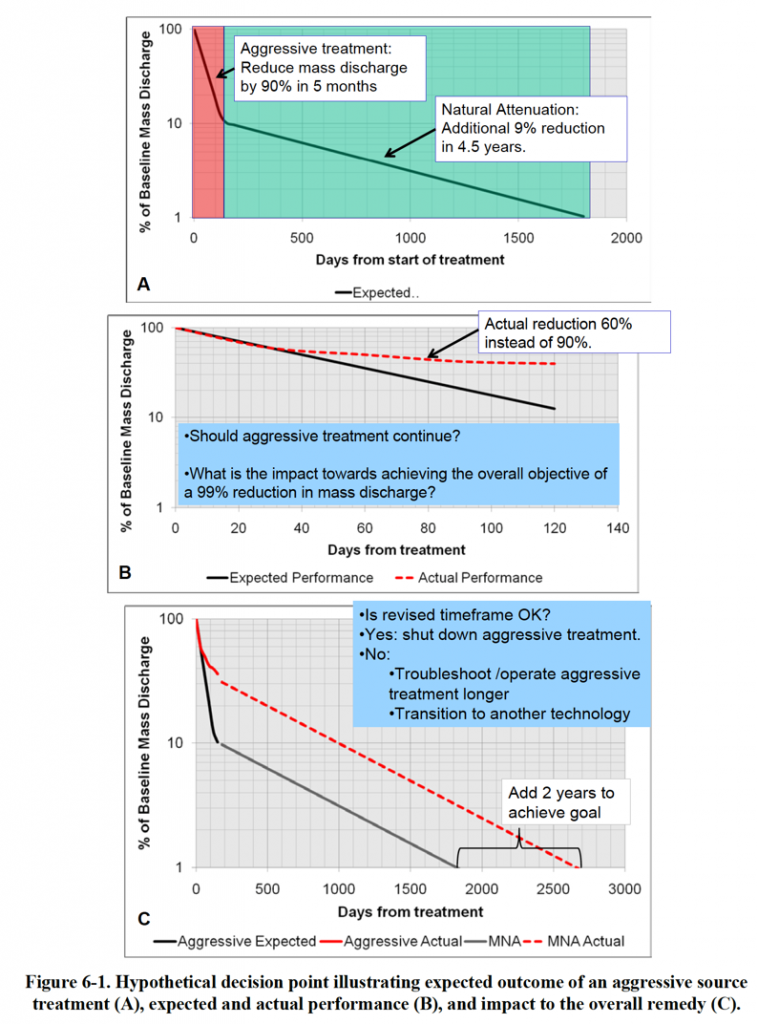
6.4 Summary
Regardless of the difficulty of remediating chlorinated solvent–contaminated sites, there are numerous case studies demonstrating that the use of performance-based goals, combined with regular assessment and optimization of remedial activities, can lead to timely and cost-effective protection of human health and the environment. Examples of successful site management strategies contain case studies (USEPA 2009a Ryan 2010) that have either resulted in site closure or achieved remedial goals that have substantially reduced the remediation time frame and/or site management costs. However in some cases, despite best efforts, it may become apparent that the original objectives may not be attainable in a reasonable time frame. Examples of regulatory options available for these types of sites are provided on the “Regulatory Issues/ Challenges” page of the Mining Waste Treatment Technology Selection website (ITRC 2010a) at https://projects.itrcweb.org/miningwaste-guidance/
Thirty years has provided valuable insights into effective management and remediation of chlorinated-solvent sites. In essence, this IDSS guidance describes a process for developing an adaptive strategy for complex and dynamic chlorinated solvent DNAPL sites, which includes identification of key decision points to be periodically revisited, updated, and/or improved. This process includes identifying decisions points regarding when and how changes to the treatment strategy should be made. The adaptive elements of an IDSS include the following:
- an improved and living CSM that is updated throughout the remedy as new information becomes available and new decisions need to be made (Chapters 2 and 6)
- SMART objectives that relate specific performance criteria to actions (e.g., technologies that are periodically evaluated to ensure they continue to make acceptable progress and remain cost-efficient (Chapters 3 and 6)
- appropriate application of treatment options based on realistic expectations of performance and flexibility in technology transition when a point of diminishing returns has been realized or an alternative approach could achieve the objectives more cost-effectively (Chapters 4 and 6)
- iterative performance evaluation to determine whether acceptable interim progress objectives are being achieved or optimization or reevaluation of the IDSS is warranted (Chapters 5 and 6)
- an iterative approach to reevaluate the strategy and even change the approach when objectives are not being met or alternative methods offer the same or better outcome at lower costs or in less time (Chapter 6)
Although the IDSS does not provide easy answers, it does acknowledge the difficulties and compartmentalize the problem, enabling more effective site-management decisions. Accordingly, an understanding of all the elements can be gained by stakeholders that enable more effective decisions regarding how to manage sites. It is now recognized that management of a chlorinated-solvent sites is a lengthy process of site study, remediation, and post-remedial review. Some sites have contaminants remaining after the remedy is complete that require long- term monitoring and review.
The IDSS provides a means to improve monitoring and feedback mechanisms focused on crucial unknowns or uncertainties at the site and to revisit and adjust prior decisions, as warranted, in light of new information. In particular, the IDSS can improve information gathering and review in recognition of other important considerations, such as anticipated future uses of the site or remediation budgets and insurance options. Ultimately, the IDSS creates an accurate, comprehensive management model for sites at which chlorinated solvent occurs in multiple phases and is remedied using several methods over an extended period of time and under conditions of uncertainty and change.
